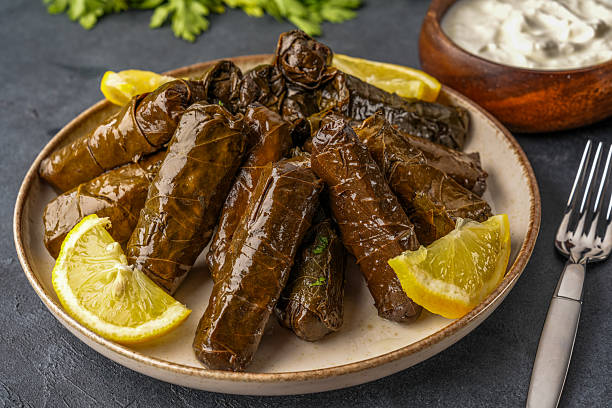
Introduction: The Timeless Charm of Dolma
Dolma is more than just a meal it’s a piece of Mediterranean heritage wrapped in tender grape leaves. Known by different names across cultures, Dolma has been enjoyed for centuries and remains one of the most beloved dishes in Middle Eastern, Greek, and Turkish cuisines. The word “Dolma” comes from the Turkish verb dolmak, meaning “to fill.” It’s the perfect name for this dish, which consists of grape leaves filled with a fragrant blend of rice, herbs, and sometimes meat. There’s something incredibly heartwarming about Dolma. It’s the kind of dish that brings families together, where generations sit around the table rolling leaves and chatting while preparing this flavorful feast. Whether served warm as a main course or cold as an appetizer, Dolma captures the spirit of home-cooked comfort. Every bite tells a story a story of history, family, and flavour .according to modern and busy era dolma is like cake decorating parties bust people arrange for there meetups.
The Fascinating History of Dolma
Tracing Dolma’s Roots through the Mediterranean and Middle East
Dolma has deep historical roots that trace back thousands of years. Some food historians believe it originated in ancient Persia, where stuffed vegetables were a royal delicacy. As empires expanded and trade flourished, the dish traveled across the Ottoman Empire, evolving with every culture it touched. Greeks, Turks, Armenians, Arabs, and even people from the Balkans claim Dolma as part of their culinary identity. Despite its variations, the concept remained the same stuffing vegetables or grape leaves with rice and spices. Over time, Dolma became a staple dish across the Mediterranean, symbolizing abundance and hospitality. Whether it’s called Dolmades in Greece, Sarma in Turkey, or Mahshi in Arabic countries, the essence is always the same: a beautiful union of simple ingredients elevated by love and patience.
The Cultural Symbolism Behind Dolma
Dolma is more than food it’s a celebration. It represents generosity, warmth, and the art of sharing. In many households, Dolma-making is a communal activity where family members gather, chat, and roll grape leaves together. It’s often served at weddings, religious holidays, or special gatherings, where it symbolizes prosperity and love. Across the Middle East, serving Dolma to guests is a gesture of respect. It shows that the host took time and care to prepare something special. The beauty of Dolma is that it connects people, transcending borders and languages, proving that food truly is a universal language.
Understanding the Core of Dolma – Grape Leaves and Rice
The Role of Grape Leaves in Dolma
At the heart of Dolma lies its most distinctive ingredient: grape leaves. They lend a unique earthy flavor and delicate texture that perfectly complements the aromatic filling. You’ll need one 16-ounce jar of grape leaves in brine (about 60 to 70 leaves) for a family-sized batch. These leaves are preserved in brine to maintain their freshness and flexibility. Before using them, rinse the leaves thoroughly under cold water to remove excess salt. If they feel too firm, blanch them briefly in warm water to soften them. The perfect grape leaf should be tender, vibrant green, and pliable enough to roll without tearing. Once prepared, these leaves become nature’s perfect wrapping paper for the flavorful rice and meat filling inside .you can easily buy them from amazon.
The Importance of Short-Grain Rice and Fresh Herbs
The filling is the soul of Dolma. The secret lies in using 1 ½ cups of short-grain rice, soaked for about 15 minutes to remove starch and ensure even cooking. Short-grain rice is preferred because it becomes tender and slightly sticky, helping bind the filling together beautifully. The rice is then mixed with fresh parsley, dill, and mint—½ cup of each, finely chopped. These herbs add vibrant freshness and aroma, transforming the filling into a bouquet of Mediterranean flavors. The addition of 1 large yellow onion, finely chopped, provides a sweet, savory depth, while 12 oz of lean ground beef adds richness and texture. To elevate the flavor, season with kosher salt, black pepper, 1 teaspoon of allspice, and ½ teaspoon of cumin. Finally, drizzle in extra virgin olive oil, such as Private Reserve Greek EVOO, for a luscious finish. The result? A fragrant, colorful filling that will make your kitchen smell heavenly.
Essential Ingredients for Authentic Dolma
Here’s everything you’ll need to make authentic Dolma at home:
- 1 16-oz jar grape leaves in brine (about 60–70 leaves)
- 1 ½ cup short grain rice, soaked and drained
- Extra virgin olive oil (Private Reserve Greek EVOO recommended)
- 1 large yellow onion, finely chopped
- 12 oz lean ground beef
- Kosher salt and black pepper to taste
- 1 tsp allspice
- ½ tsp cumin
- ½ cup chopped fresh parsley
- ½ cup chopped fresh dill
- ½ cup chopped fresh mint
- 1–2 tomatoes, sliced into rounds
- About 4 cups or more of low-sodium chicken broth or water
- Juice of 2 lemons
Why Each Ingredient Matters
Every ingredient in Dolma serves a purpose. Olive oil ensures the filling stays moist and flavorful, while onions bring sweetness and balance. The blend of herbs and spices mint for freshness, dill for brightness, and allspice for warmth creates a harmonious aroma that defines the dish. The sliced tomatoes layered at the bottom of the pot prevent the Dolma from burning and infuse the rolls with subtle sweetness. The chicken broth or water adds depth, transforming the Dolma into a tender, melt-in-your-mouth delight. Lastly, the juice of two lemons gives it that signature tangy kick that ties everything together. Each bite becomes a perfect blend of savory, zesty, and aromatic flavors.
Step-by-Step Guide: How to Make Authentic Dolma
Step 1: Prepare the Filling
In a large bowl, combine the soaked and drained rice, chopped onions, lean ground beef, parsley, dill, mint, salt, black pepper, allspice, and cumin. Mix everything with a drizzle of olive oil until well combined. The mixture should be moist but not wet if it feels too dry, add a splash of broth or more olive oil.
Step 2: Stuff and Roll the Grape Leaves
Lay one grape leaf shiny side down on a flat surface after blanching them in hot water for 5 to 6 minutes. Place about a teaspoon of filling near the stem end. Fold the sides over the filling, then roll tightly toward the tip, just like a tiny burrito. Be gentle but firm too loose and it’ll unravel; too tight and it might tear. Repeat with the remaining leaves. Line the bottom of a large pot with the tomato slices to prevent sticking. Arrange the stuffed grape leaves seam side down, packing them tightly in layers.
Step 3: Cook the Dolma
Pour in 4 cups of low-sodium chicken broth or water enough to cover the rolls. Drizzle with olive oil and squeeze in the juice of 2 lemons. Place a heatproof plate over the Dolma to keep them from floating or unraveling. Cover the pot with a lid and bring it to a gentle simmer over medium heat. Cook for about 45–60 minutes, or until the rice and meat are fully cooked and the grape leaves are tender. Once done, let them cool slightly before serving. You’ll notice the rich aroma of herbs and lemon filling your kitchen it’s truly irresistible.
Pro Tips for Making the Best Dolma Every Time
Don’t overstuff the grape leaves rice expands as it cooks. Keep the rolls tight so they don’t open up during cooking. Use fresh herbs generously; they define Dolma’s Mediterranean character. Simmer slowly; rushing the process can toughen the leaves. Always rest before serving letting Dolma sit for 15–20 minutes helps the flavors meld perfectly. These small details make all the difference between an average Dolma and a show-stopping one.
Serving Suggestions and Pairings
Dolma can be served warm or cold, depending on your preference. If served warm, drizzle extra lemon juice and olive oil before presenting. For a refreshing side, pair Dolma with Greek yogurt, tzatziki, or a cucumber salad. It also pairs beautifully with hummus, olives, or pita bread. For drinks, consider serving Dolma with a crisp white wine or mint-infused iced tea. On festive occasions, arrange Dolma on a platter lined with lemon wedges and fresh herbs it’ll look as good as it tastes!
Health Benefits of Dolma
Dolma isn’t just delicious it’s nutritious too. Grape leaves are low in calories and rich in fiber, vitamins A and K, and antioxidants. The combination of rice, herbs, and olive oil provides a balanced source of carbohydrates and healthy fats. Using lean ground beef adds protein while keeping the dish light. Olive oil, a key ingredient in the Mediterranean diet, supports heart health and reduces inflammation. The lemon juice adds a vitamin C boost, making Dolma not only tasty but also wholesome.
Regional Variations of Dolma
Dolma varies across regions: Greek Dolmades are typically vegetarian and served cold with lemon. Turkish Sarma is often spiced with cinnamon or pine nuts. Middle Eastern Dolma usually includes meat and more lemon for a tangy flavor. Even within countries, families have their own cherished versions, passed down for generations.
Dolma as a Symbol of Family and Love
In Mediterranean households, making Dolma is a family event. Everyone has a role some rinse leaves, others roll them. It’s a time of laughter, stories, and connection. The process itself becomes a memory, a way to bond and celebrate heritage. Serving Dolma to guests is an act of hospitality, representing warmth and welcome. In many ways, Dolma is not just food it’s love wrapped in a leaf.
Common Mistakes to Avoid When Making Dolma
Overstuffing the leaves leads to bursting while cooking. Skipping the plate weight causes Dolma to unravel. Using unsoaked rice results in uneven cooking. Cooking on high heat makes the leaves tough and dry. Avoid these pitfalls, and your Dolma will turn out perfect every time.
Storing and Reheating Dolma
Dolma stores beautifully. Once cooled, transfer to an airtight container and refrigerate for up to 5 days. To reheat, place them in a pot with a splash of water and warm over low heat. You can also freeze Dolma for up to 3 months just thaw overnight before reheating. The flavors actually deepen after a day or two, making leftovers even more delicious!
Conclusion: Dolma – A Bite of Heritage and Love
Dolma is more than a dish it’s a story of tradition, patience, and love. From the delicate grape leaves to the fragrant herb-infused filling, every bite offers a taste of Mediterranean warmth. Whether you’re making it for family, friends, or just yourself, Dolma turns an ordinary meal into a celebration of culture and flavor. So, the next time you crave something hearty, healthy, and deeply satisfying, roll up your sleeves and make Dolma. It’s not just cooking it’s preserving a legacy.
FAQs About Dolma
1. Can I make Dolma vegetarian? Yes! Skip the meat and double the herbs. You can also add chopped tomatoes or pine nuts for texture.
2. Can I use fresh grape leaves? Yes. Blanch them for 1–2 minutes in boiling water to soften before rolling.
3. What’s the best way to serve Dolma? Serve warm with a drizzle of olive oil and lemon juice, or cold with yogurt sauce.
4. How long does Dolma last in the fridge? Up to 5 days in an airtight container.
5. Can I make Dolma ahead of time? Yes! It actually tastes better after a day as the flavors meld beautifully.
Please don’t forget to leave a review.
